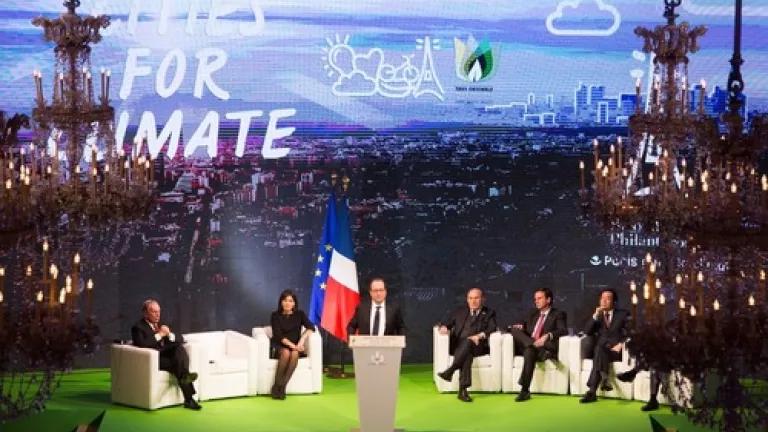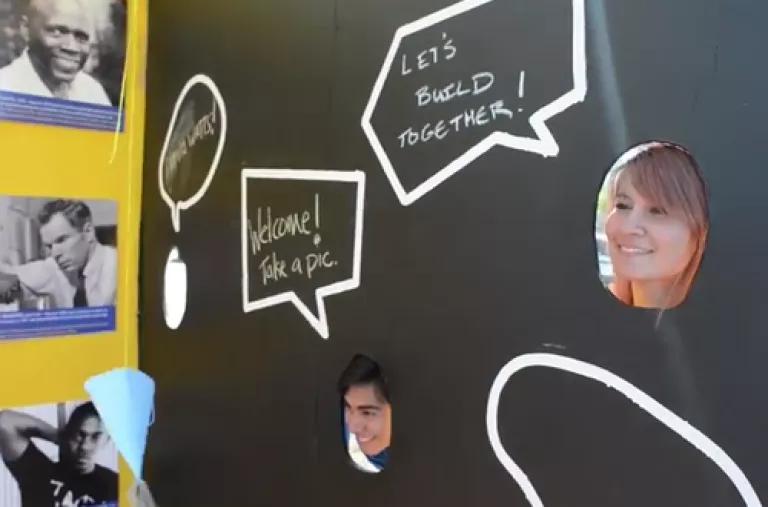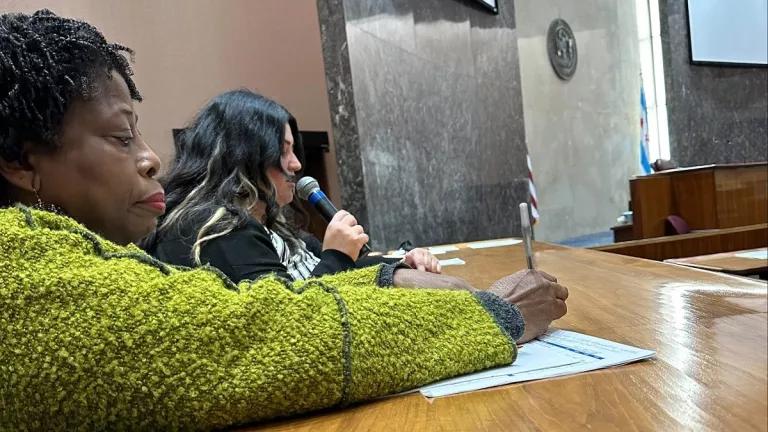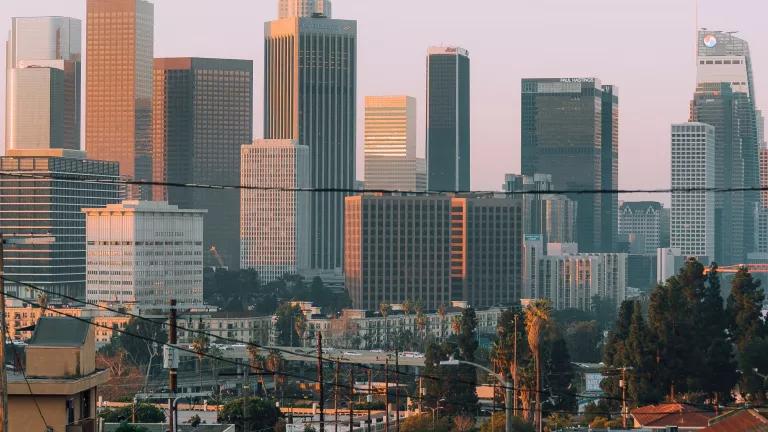
Cities are the nexus of life, more so now than ever in history. They are praised for their culture while being denounced for their tension and divisions.They are either bustling with excitement or overcrowded and overpriced. But I imagine if cities had a collective brain, they would adopt a more philosophical and even, yes, urbane attitude, perhaps along the lines of an Oscar Wilde sentiment that the only thing worse than being talked about "is not being talked about."
Cities were, indeed, the center of attention in 2015, and I suspect the talk will continue for decades to come because our world is changing to a focus on urban centers as spheres for humanity's biggest challenges and its best solutions.
Of course, it helps my premise that 2015 ended with representatives from around the world meeting in one place to discuss the role of cities in literally saving the planet. It was gratifying to have been in Paris at the 21st Conference of the Parties (COP21), which refers to the countries that have signed on to the 1992 U.N. Framework Convention on Climate Change, and to have been even a small part of a global discussion on how cities are helping stem a dangerous rise in Earth's temperature, using their nimbleness and savvy to best advantage at the local level.
Going local
"The challenge is global, but the solutions and actions are local," Paris Mayor Anne Hidalgo told The New York Times in an interview at the conference. "We can ask for all kinds of international rules, if it were not for the measures carried out by the main actors -- cities, citizens, the private sector, NGOs -- there would be no result."
NRDC Urban Solutions was there as a program of one of those NGOs to announce -- with the help of actor and environmentalist Robert Redford -- millions of dollars of additional funding and a three-year expansion of the City Energy Project. This project, which we are co-leading with the Institute for Market Transformation, is focused on helping cities address the biggest energy-wasters of them all -- the massive buildings that we often love the most in our urban centers and that represent enormous carbon-emissions reduction opportunities.
Did you know, in fact, that if U.S. buildings were their own country, they would rank third in the world in energy use?
The City Energy Project is working with city governments and partners on energy efficiency in buildings in 10 major cities. Atlanta became the first city in the Southeast to pass a benchmarking and audit policy for large commercial buildings, potentially leading to a 20 percent reduction in commercial energy use by 2030, the creation of thousands of jobs and a reduction in carbon emissions by 50 percent.
It also parallels our work in 12 states on increasing energy efficiency in multifamily housing with the potential to cut electricity usage by as much as 26 percent, and our efforts overall on buildings, specifically in New York City, which won the C40 Building Energy Efficiency award in Paris.
Over the last two years, working with a wide-ranging coalition of community-based, housing and environment groups, the Energy Efficiency for All project -- of which NRDC is a member, along with National Housing Trust, Energy Foundation and Elevate Energy -- has helped to secure about $70 million for underserved low-income communities.
Cars and their legacy
Another major pillar for tackling climate change in cities - transportation.
The year 2015 saw the invention of Live. Ride. Share., a conference that kicked off in Los Angeles' Little Tokyo neighborhood when hundreds of transportation's thinkers and doers gathered to envision a more sustainable and equitable future with substantially fewer cars. California was an appropriate location because of the state's long history of efforts to cut carbon pollution in transportation and our own legacy of activism in the state.
Live. Ride. Share. is designed to sync the goals for all forms of transportation - with a heavy dose of technology thrown in - to bring a new vision for life in cities incorporating ride-sharing, ride-hailing and other unique transportation forms. Part of the goal is making communities of color important stakeholders in that vision. The next conference is set for Denver in May.
We're also keeping tabs on important federal legislation on transportation even if it's a sometimes thankless job and perhaps a bit scary as well.
Water
Megastorm Patricia in Mexico and Hurricane Joaquin - with its accompanying 1,000-year floods in South Carolina -- reminded us in 2015 that apocalyptic storms can devastate American communities and that doesn't include the smaller water-related disasters with every hard rain in virtually every city.
There are climate-related reasons for these problems, and they are depressingly ubiquitous, costly and potentially dangerous to public health. As 2015 came to a close, we decided to look at how much taxpayer money has gone to repair or rebuild flood-damaged public utilities in the United States.
There's some good news here, at least for the future: In January of 2015, a White House executive order updated the flood protection standard to make sure the designs of federally funded projects in or near floodplains and along coastlines are better suited to face a greater risk of flooding in the future.
Money
Pledges for emissions reductions by nations at COP21 are, of course, hugely significant but they aren't enough to put the world on the path to keeping global temperature rise below 2 degrees Celsius. Governments don't have to try to do it alone. A profound transformation in global energy investment is needed, and that's where green banks come in.
We also announced in Paris that we were collaborating with several green banks to establish a Green Bank Network to help meet the financing needs for installing renewable energy and energy efficiency around the world. Having banks work together in a network will increase the banks' global impact in spurring investment in things like solar and wind energy, reducing greenhouse gas emissions and better preserving our natural resources.
Infrastructure with a higher purpose
No one wants to be driving across a bridge or riding in a train or transit car and feel his or her life is at risk. Of course, basic improvements are needed but there is much more to the infrastructure discussion.
Many cities don't have the capacity to implement visionary infrastructure plans, usually defaulting to the same old projects that got us into the mess we're in. NRDC partnered with Build America, a White House-led initiative with the Ford Foundation, Clinton Global Initiative, Harvard University and a host of economists, engineers and NGOs to look at why more and better infrastructure isn't getting built. We focused on "pre-development" -- getting projects ready for investment -- and created a methodology that could help standardize the way infrastructure projects are designed and funded.
Equity
As demonstrated by many of the above projects, equity is fundamental to our work.

This year we underscored that commitment in South Central LA with a commemoration of the 50th anniversary of the Watts uprising as part of a project called Watts Re:Imagined. It's a blueprint for sustainable urban revitalization that's designed to promote economic opportunity, social equity and environmental stewardship in a community with one of the lowest income levels in the country.The kickoff included a colorful block party and celebration, and the work -- documented in this newly released video -- continues.
We also weighed in on some important national developments, including the Clean Power Plan, the U.S.-China Climate Leaders Summit in Los Angeles, new research on how the neighborhoods in which we are raised help determine our success in life, and the action by the Obama administration to require cities to scrutinize their housing patterns for racial bias.
As I said then, "For far too long, our challenge has been to dig deep into our racial and economic history and pinpoint the barriers that prevent some Americans from enjoying what many of us take for granted -- clean air and water, affordable housing, safe streets, good schools, healthy food and convenient and affordable access to jobs.
"These rules ... have the potential to level the playing field, offering low-income Americans the chance to raise their families in neighborhoods where there are more choices for a brighter future.''
A new year
Our work this year has taken us to the White House, the State Department, Paris-Le Bourget and other corridors of power, but it has also been an entrée into neighborhoods and people's homes -- where simple things like energy-efficient windows, heaters and appliances mean lower asthma rates for kids and more comfortable lives for the elderly and homebound.
If it's time for year-end resolutions, mine would be to keep that people-centered side of the equation at the forefront of our work in 2016.




